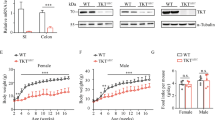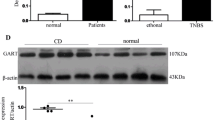Abstract
Background
Pyruvate kinase M2 (PKM2), a key glycolytic enzyme, is involved in multiple cellular processes including apoptosis. Recently increased fecal PKM2 has been found in Crohn’s disease (CD), but little is known regarding its function in the pathophysiology of the disease.
Aim
The intestinal expression of PKM2 and its involvement in CD was investigated.
Methods
Pyruvate kinase M2 expression in mucosal biopsies from patients with CD and normal controls was detected by immunohistochemistry. A murine model of colitis induced by trinitrobenzenesulphonic acid (TNBS) was established and expression of PKM2, B cell lymphoma-extra large (Bcl-xl), active caspase-3 as well as cleaved poly (ADP-ribose) polymerase (PARP) was examined for association of PKM2 with intestinal epithelial cell (IEC) apoptosis. Furthermore, we treated human IEC line HT-29 by tumor necrosis factor-α (TNF-α) and used RNA interference to analyze the role of PKM2 in IEC apoptosis.
Results
Intestinal expression of PKM2 was higher in patients with CD compared with normal controls mainly locating in IECs. In TNBS-induced colitis, up-regulation of PKM2 was accompanied by the elevated expression of Bcl-xl, active caspase-3, and cleaved PARP. PKM2 was co-localized with active caspase-3 in IECs marked by E-cadherin, suggesting its role in IEC apoptosis. Expression of PKM2 and Bcl-xl in TNF-α-induced HT-29 cells was increased, while TNF-α had no effect on cellular localization of PKM2. Furthermore, knockdown of PKM2 by siRNA could inhibit expression of Bcl-xl but enhance apoptosis in TNF-α-treated HT-29 cells.
Conclusion
The up-regulation of PKM2 might protect IECs against apoptosis possibly through Bcl-xl in CD, indicating its important role in the pathophysiology of CD.






Similar content being viewed by others
References
Lichtenberger GS, Flavell RA, Alexopoulou L. Innate immunity and apoptosis in IBD. Inflamm Bowel Dis. 2004;10:S58–S62.
Jess T, Loftus EV Jr, Velayos FS, Harmsen WS, et al. Risk of intestinal cancer in inflammatory bowel disease: a population-based study from olmsted county, Minnesota. Gastroenterology. 2006;130:1039–1046.
Busch K, Ludvigsson JF, Ekstrom-Smedby K, Ekbom A, et al. Nationwide prevalence of inflammatory bowel disease in Sweden: a population-based register study. Aliment Pharmacol Ther. 2014;39:57–68.
Solberg IC, Vatn MH, Hoie O, Stray N, et al. Clinical course in Crohn’s disease: results of a Norwegian population-based ten-year follow-up study. Clin Gastroenterol Hepatol. 2007;5:1430–1438.
Zheng JJ, Shi XH, Zhu XS, Huangfu Z, Guo ZR. A comparative study of incidence and prevalence of Crohn’s disease in mainland China in different periods. Zhonghua Nei Ke Za Zhi. 2011;50:597–600.
Kim MJ, Choe YH. Change in the treatment strategy for pediatric Crohn’s disease. Korean J Pediatr. 2010;53:830–833.
Keita AV, Soderholm JD. Barrier dysfunction and bacterial uptake in the follicle-associated epithelium of ileal Crohn’s disease. Ann N Y Acad Sci. 2012;1258:125–134.
Ruemmele FM, Seidman EG, Lentze MJ. Regulation of intestinal epithelial cell apoptosis and the pathogenesis of inflammatory bowel disorders. J Pediatr Gastroenterol Nutr. 2002;34:254–260.
Scharl M, McCole DF, Weber A, Vavricka SR, et al. Protein tyrosine phosphatase N2 regulates TNFalpha-induced signalling and cytokine secretion in human intestinal epithelial cells. Gut. 2011;60:189–197.
Di Sabatino A, Ciccocioppo R, Luinetti O, Ricevuti L, et al. Increased enterocyte apoptosis in inflamed areas of Crohn’s disease. Dis Colon Rectum. 2003;46:1498–1507.
Schulzke JD, Bojarski C, Zeissig S, Heller F, et al. Disrupted barrier function through epithelial cell apoptosis. Ann N Y Acad Sci. 2006;1072:288–299.
Mukherjee J, Phillips JJ, Zheng S, Wiencke J, et al. Pyruvate kinase M2 expression, but not pyruvate kinase activity, is up-regulated in a grade-specific manner in human glioma. PLoS ONE. 2013;8:e57610.
Mazurek S, Boschek CB, Hugo F, Eigenbrodt E. Pyruvate kinase type M2 and its role in tumor growth and spreading. Semin Cancer Biol. 2005;15:300–308.
Mazurek S. Pyruvate kinase type M2: a key regulator of the metabolic budget system in tumor cells. Int J Biochem Cell Biol. 2011;43:969–980.
Harris I, McCracken S, Mak TW. PKM2: a gatekeeper between growth and survival. Cell Res. 2012;22:447–449.
Wong N, De Melo J, Tang D. PKM2, a central point of regulation in cancer metabolism. Int J Cell Biol. 2013;2013:242513.
Day AS, Judd T, Lemberg DA, Leach ST. Fecal M2-PK in children with Crohn’s disease: a preliminary report. Dig Dis Sci. 2012;57:2166–2170.
Jeffery J, Lewis SJ, Ayling RM. Fecal dimeric M2-pyruvate kinase (tumor M2-PK) in the differential diagnosis of functional and organic bowel disorders. Inflamm Bowel Dis. 2009;15:1630–1634.
Goldberg MS, Sharp PA. Pyruvate kinase M2-specific siRNA induces apoptosis and tumor regression. J Exp Med. 2012;209:217–224.
Guo W, Zhang Y, Chen T, Wang Y, et al. Efficacy of RNAi targeting of pyruvate kinase M2 combined with cisplatin in a lung cancer model. J Cancer Res Clin Oncol. 2011;137:65–72.
Kwon OH, Kang TW, Kim JH, Kim M, et al. Pyruvate kinase M2 promotes the growth of gastric cancer cells via regulation of Bcl-xL expression at transcriptional level. Biochem Biophys Res Commun. 2012;423:38–44.
Michels J, Kepp O, Senovilla L, Lissa D, et al. Functions of BCL-X L at the Interface between Cell Death and Metabolism. Int J Cell Biol. 2013;2013:705294.
Hollenbach E, Vieth M, Roessner A, Neumann M, et al. Inhibition of RICK/nuclear factor-kappaB and p38 signaling attenuates the inflammatory response in a murine model of Crohn disease. J Biol Chem. 2005;280:14981–14988.
Neurath MF, Fuss I, Kelsall BL, Stuber E, Strober W. Antibodies to interleukin 12 abrogate established experimental colitis in mice. J Exp Med. 1995;182:1281–1290.
Tao T, Cheng C, Ji Y, Xu G, et al. Numbl inhibits glioma cell migration and invasion by suppressing TRAF5-mediated NF-kappaB activation. Mol Biol Cell. 2012;23:2635–2644.
Zhou CF, Li XB, Sun H, Zhang B, et al. Pyruvate kinase type M2 is upregulated in colorectal cancer and promotes proliferation and migration of colon cancer cells. IUBMB Life. 2012;64:775–782.
Elson CO, Sartor RB, Tennyson GS, Riddell RH. Experimental models of inflammatory bowel disease. Gastroenterology. 1995;109:1344–1367.
Qiu W, Wu B, Wang X, Buchanan ME, et al. PUMA-mediated intestinal epithelial apoptosis contributes to ulcerative colitis in humans and mice. J Clin Invest. 2011;121:1722–1732.
Danial NN. BCL-2 family proteins: critical checkpoints of apoptotic cell death. Clin Cancer Res. 2007;13:7254–7263.
Wang J, Fu YX. Tumor necrosis factor family members and inflammatory bowel disease. Immunol Rev. 2005;204:144–155.
Yan F, John SK, Polk DB. Kinase suppressor of Ras determines survival of intestinal epithelial cells exposed to tumor necrosis factor. Cancer Res. 2001;61:8668–8675.
Stetak A, Veress R, Ovadi J, Csermely P, et al. Nuclear translocation of the tumor marker pyruvate kinase M2 induces programmed cell death. Cancer Res. 2007;67:1602–1608.
Al-Sadi R, Guo S, Dokladny K, Smith MA, et al. Mechanism of interleukin-1beta induced-increase in mouse intestinal permeability in vivo. J Interferon Cytokine Res. 2012;32:474–484.
Alecu L, Ursut B, Obrocea F, Marinescu E, et al. The surgical treatment for Crohn’s disease. Chirurgia (Bucur). 2013;108:463–467.
Wolters FL, Russel MG, Stockbrugger RW. Systematic review: has disease outcome in Crohn’s disease changed during the last four decades? Aliment Pharmacol Ther. 2004;20:483–496.
Edelblum KL, Yan F, Yamaoka T, Polk DB. Regulation of apoptosis during homeostasis and disease in the intestinal epithelium. Inflamm Bowel Dis. 2006;12:413–424.
Kefas B, Comeau L, Erdle N, Montgomery E, et al. Pyruvate kinase M2 is a target of the tumor-suppressive microRNA-326 and regulates the survival of glioma cells. Neuro Oncol. 2010;12:1102–1112.
Shi HS, Li D, Zhang J, Wang YS, et al. Silencing of pkm2 increases the efficacy of docetaxel in human lung cancer xenografts in mice. Cancer Sci. 2010;101:1447–1453.
Porter AG, Janicke RU. Emerging roles of caspase-3 in apoptosis. Cell Death Differ. 1999;6:99–104.
Lee SY, Debnath T, Kim SK, Lim BO. Anti-cancer effect and apoptosis induction of cordycepin through DR3 pathway in the human colonic cancer cell HT-29. Food Chem Toxicol. 2013;60:439–447.
Gao X, Wang H, Yang JJ, Chen J, et al. Reciprocal regulation of protein kinase and pyruvate kinase activities of pyruvate kinase M2 by growth signals. J Biol Chem. 2013;288:15971–15979.
Zhao Y, Altman BJ, Coloff JL, Herman CE, et al. Glycogen synthase kinase 3alpha and 3beta mediate a glucose-sensitive antiapoptotic signaling pathway to stabilize Mcl-1. Mol Cell Biol. 2007;27:4328–4339.
Tarze A, Deniaud A, Le Bras M, Maillier E, et al. GAPDH, a novel regulator of the pro-apoptotic mitochondrial membrane permeabilization. Oncogene. 2007;26:2606–2620.
Loar P, Wahl H, Kshirsagar M, Gossner G, et al. Inhibition of glycolysis enhances cisplatin-induced apoptosis in ovarian cancer cells. Am J Obstet Gynecol. 2010;202:e1–e8.
Chipuk JE, Moldoveanu T, Llambi F, Parsons MJ, Green DR. The BCL-2 family reunion. Mol Cell. 2010;37:299–310.
Israelsen WJ, Dayton TL, Davidson SM, Fiske BP, et al. PKM2 isoform-specific deletion reveals a differential requirement for pyruvate kinase in tumor cells. Cell. 2013;155:397–409.
Feagins LA, Souza RF, Spechler SJ. Carcinogenesis in IBD: potential targets for the prevention of colorectal cancer. Nat Rev Gastroenterol Hepatol. 2009;6:297–305.
Walkowiak J, Banasiewicz T, Krokowicz P, Hansdorfer-Korzon R, et al. Fecal pyruvate kinase (M2-PK): a new predictor for inflammation and severity of pouchitis. Scand J Gastroenterol. 2005;40:1493–1494.
Czub E, Herzig KH, Szaflarska-Popawska A, Kiehne K, et al. Fecal pyruvate kinase: a potential new marker for intestinal inflammation in children with inflammatory bowel disease. Scand J Gastroenterol. 2007;42:1147–1150.
Acknowledgments
This work was supported by the Natural Science Foundation of China (No. 81201252), the Jiangsu Province’s Key Provincial Talents Program (RC2011079), and the Project of the six talent summit of Jiangsu Province (2009-B1-002).
Conflict of interest
None.
Author information
Authors and Affiliations
Corresponding authors
Additional information
Qiyun Tang and Qianqian Ji have contributed equally to this study.
Rights and permissions
About this article
Cite this article
Tang, Q., Ji, Q., Xia, W. et al. Pyruvate Kinase M2 Regulates Apoptosis of Intestinal Epithelial Cells in Crohn’s Disease. Dig Dis Sci 60, 393–404 (2015). https://doi.org/10.1007/s10620-014-3189-0
Received:
Accepted:
Published:
Issue Date:
DOI: https://doi.org/10.1007/s10620-014-3189-0




